| Liz: Last week’s Cambridge Raspberry Jam was one of the biggest yet. I asked the organisers, Michael Horne (whom you might know as Recantha: he has a brilliant Raspberry Pi blog, which you should check out) and Tim Richardson, whether they’d be prepared to write a guest post for us about the event. They’ve done so in spades. Thanks both!
IntroductionThis was a very special Jam. We had decided after the December 2013 event that we wanted to try and make each Jam different to the previous one. We had already introduced programming workshops for kids and planned to continue that into the February Jam. So, what could we do for the event after that to make it special, to make it unique? The answer lay in the aims of the Raspberry Pi Foundation: Education! We decided that for the May Jam we would have our focus on education; we just had to make the concept for the event fit the resources and space we had available. 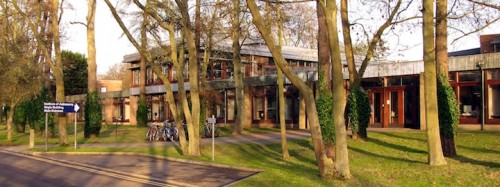 The Institute of Astronomy, Cambridge At our current venue, the Institute of Astronomy (above), we're fortunate to have the following available: a 180-seat lecture theatre; a large foyer; a small 30-person meeting room and a small mezzanine with a couple of levels. It would be fair to say we went through quite a few ideas before finally settling on the concept: We would turn the lecture theatre over to presentations for educators (calling it 'Focus on Education') and hold workshops in the meeting room and foyer. We would also have projects on display on the mezzanine (we call it 'Show and Tell') and a cut-down version of our normal marketplace around the edges of the foyer with a slant towards education where possible. Preparation… or "What does it take to make Jam for 200 people?"We've held three previous Jams at the Institute of Astronomy and have sold out each time. Normally, we sell about 180 tickets and this time we were going to be inviting educators to the party, so we knew we had to be very prepared and very organised. We simply didn't want to let anyone down, especially the teachers! Normally we meet once every week or two for a two-hour meeting to discuss progress on the various tasks that need doing. Sometimes, we meet at the pub (if you're ever in Potton, Bedfordshire, visit The Rising Sun where we meet!) and sometimes we meet round Tim's house. We realised with an event of this size and importance that we would definitely need to meet every week in the three months after the February Jam, just to make sure that everything was done. 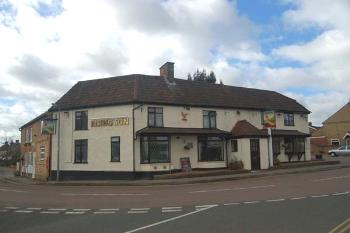 The Rising Sun, Potton – place of many-a-meeting An idea that we had been thinking about for some time was having 'maker tables', where people could bring their kit along and experts would help them out with building them, or they could buy kits at the event and make them then and there. We decided that this would be hard to plan for as we would not know what kits were coming and therefore who could help. However, the idea of making things stayed with us, so we started to plan for a number of workshops instead of the usual one. Eventually we fixed on workshops in which the Pi would detect and control the outside world: flashing LEDs (everybody likes those!), making sound, detecting temperature, light and movement, using a line follower and distance sensor, and controlling motors. On top of that, we added in using the Raspberry Pi Camera module, Minecraft and using the Pibrella add-on board. In the end we had nine hands-on workshops to sort out. Yes, nine – we must have been out of our minds! Actually, make that ten, because some bright spark had the idea of running a soldering workshop throughout the day! One of the things we wanted from the workshops was to develop a set of worksheets and kits that we could sell at close-to-cost to the people attending, which they could then take away with them. This meant ordering a lot of individual components from China and sorting them out into the kits. Tim ordered dozens of mini breadboards, hundreds of LEDs and resistors and lots and lots of sensors, along with motors, wheels and jumper cables. Which all needed to be sorted into bags. And our SD cards needed sorting out with all the software that would be required. And we also needed to find people to lead and assist in the workshops. Fortunately we'd built up an ideas-and-assistance group of about 20 people, and many of them were willing to give their time and energy to preparing the workshop material and teaching it. 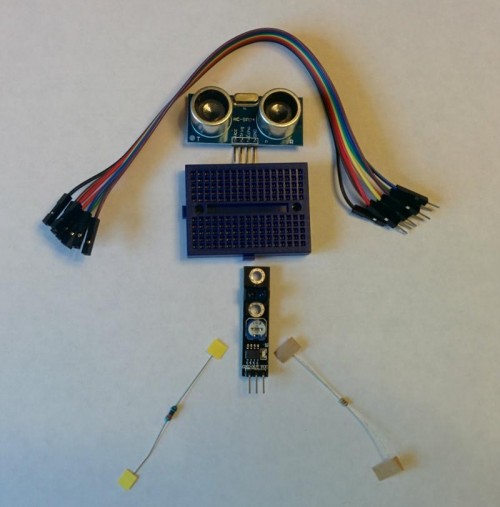 Nice sensors, man! Just a small part of the huge amount of kit ordered for the workshops. Meanwhile, Mike started sorting out a programme for the Focus on Education and asking people to the Show and Tell, doing a lot of the Jam & EventBrite admin and communications along the way. So, as you can tell, weekly meetings were a must! On the daySo, there we were, and suddenly it was three months later: the 10th of May had swung around. We had even managed to find time to hold a social Jam (Potton Pi and Pints) in the meantime just to keep in touch with everyone. At 8.30am on the morning of the 10th, we hit our first snag. Normally, we can get everything in Tim's estate car (which is, basically, a huge cavern) for the trip to Cambridge. This time, however, we had a lot more to transport: we'd bought some tables plus all the kit for the workshops meant that we just couldn't fit everything in. So, in two cars, we set out for the Institute. The get-in for a Jam is always a bit chaotic, and damned hard work, and this time was no exception. The Institute looks very different on our arrival but, thanks to Andy Batey, (who works at the Institute, arranged the venue in the first place and is just an all-round helpful chap) we (including half-a-dozen volunteers, known as Jam Makers) manage to transform it into the configuration visitors see when they arrive. The most 'fun' task this time was to move a big marquee about 50 metres from one end of the quad to the other. Much mud was encountered!  Foyer workshop area (foreground), Marketplace (left) and Show and Tell mezzanine (top right) If you want to get a feel for the day overall, Mathew and Leo have put together this brilliant video. You can even spot Tim (getting interviewed at the beginning) and Mike (with the loudhailer): You might also want to listen to this podcast from Alan O'Donohoe which was recorded at the Jam. Our first activity started at 11.10am and it was a Minecraft workshop led by Craig Richardson, Matt Timmons-Brown and Clare Macrae. This workshop had sold out within 1 hour of the free tickets becoming available. We'd had to cancel another workshop that we had been planning and replace it with a repeat of the Minecraft workshop, and that one sold out as well! We ended up with a waiting list big enough that we could have held another one! Minecraft is a major draw for kids. 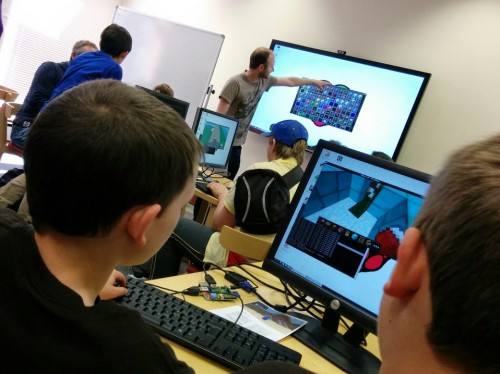 Minecraft workshop number 1: Craig attempts the impossible by trying to reach into the big screen Once we'd got that workshop going, it was all hands on deck to get the rest of the venue ready. Matt Manning, Andrew Scheller and Tim were our welcome team, and attempted the near-impossible task of checking tickets and ticking names off the registration list. With the teachers beginning to arrive, it got very busy, very quickly! Mike and Tim had decided to split up so that Tim was outside managing the workshop preparations while Mike hosted the Focus on Education in the lecture theatre. We swapped halfway through the day. Mike and Tim kicked off Focus on Education with a quick intro and then handed over to Clive Beale from the Foundation who was delivering the keynote: "Computing in Education and the new Curriculum". After Clive, Elizabeth Crilly from STEMNET and David Whale talked about the STEM Ambassador programme and what they can do for schools. We then had a more practical presentation from Dr Sam Aaron, the developer of Sonic Pi. Sam's a real rock star when it comes to live demos! At the same time, in the meeting room we had a PiCamera workshop run by Jarle Teigland, Matt Manning and Andrew Schelle and in the foyer we had a beginners electronics/breadboarding workshop run by Alex Eames, Sway Grantham and Andrew Gale. 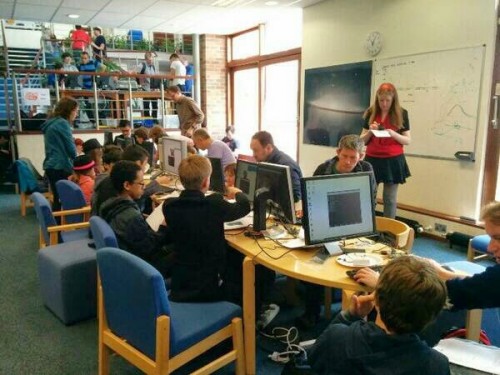 Sway and Andrew watch over the basic electronics workshop Back in the lecture theatre, we continued our presentation with Sophie Deen talking about Code Club and Code Club Pro (video not available) and then two live demo-style talks from Gordon Henderson (who covered FUZE and Return to BASIC): and Darren Christie (who talked about the Pibrella and how simple it is to use): At the same time as all of this, of course, we had our soldering workshop going on. Over 30 people took advantage of the free lessons given by Gee Bartlett (from Pimoroni) and Andrew Gale. They took place outside under a tent (so we didn't set the fire alarms inside off!). We should mention at this point that we had a lot of generosity from the community with the soldering – Gee brought a load of stuff with him, including some kits that lit up; David Whale donated an entire box of oddments; Tom Hartley donated a batch of old AirPi boards. 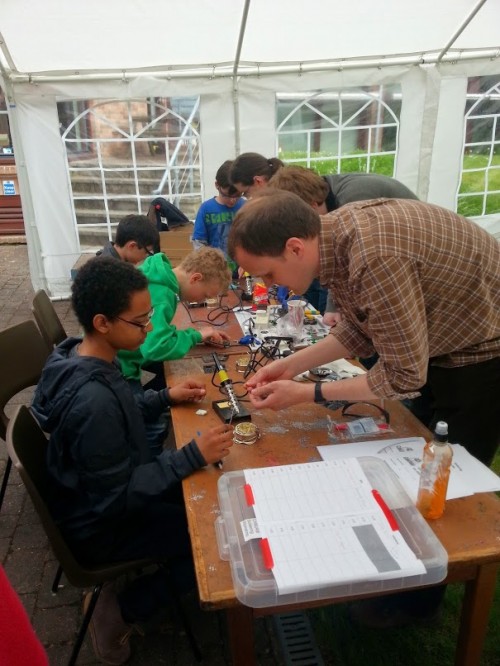 Andrew Gale teaches Sidney the finer points of not touching the hot end We also had our Show and Tell area in full swing. We had projects from Brian Corteil, Russell Barnes, Ryan Walmsley, Ipswich School, Wayne Keenan, Stewards Academy and Zach Igielman. Alex Eames was also to be found here showing off the latest prototype of the HDMIPi. 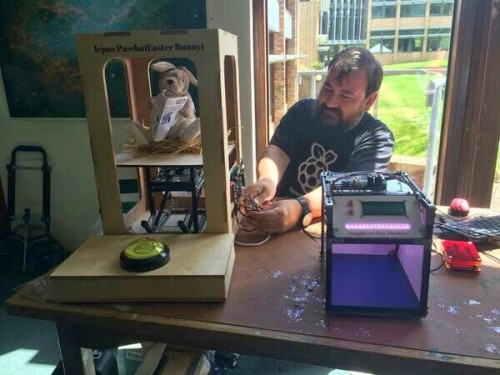 Brian Corteil and his naughty-and-nice machine (right) and egg-dispensing Easter bunny (left) 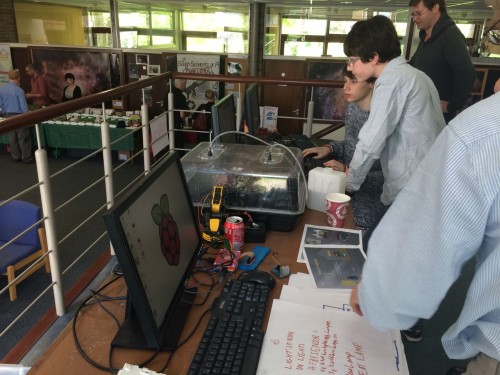 Kids from Ipswich School showing off their automatic greenhouse watering system 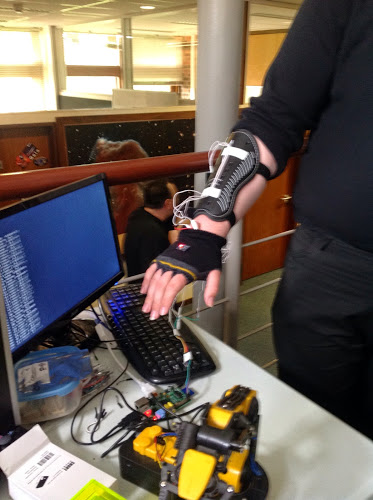 Joseph from Stewards Academy shows off his robotic arm controlled by his real arm We should also mention the exhibitors in the marketplace – we had the FUZE team, a group from the Little British Robot Company, Cyntech, The Pi Hut, GPIO.co.uk and Seven Segments of Pi. These guys really helped to give the Foyer a buzz! Concurrently with the talks, soldering and Show and Tell, Tim had in the meantime started off a further two sessions: temperature, light and movement sensors in the Foyer (led by Matt Manning & Clare Macrae) and our second Minecraft workshop in the meeting room (Craig Richardson and Matt Timmons-Brown again). 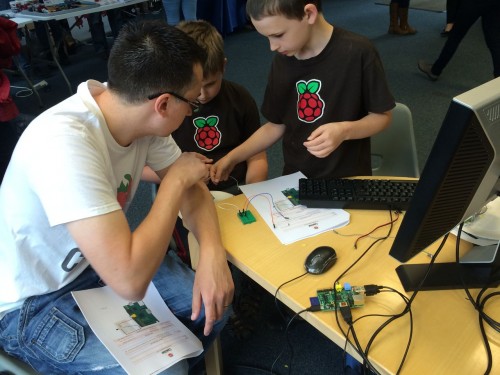 Matt Manning holds court in the sensors workshop It was half-time in the lecture theatre so Tim and Mike swapped. We hit a slight snag at this point because the entire lecture theatre emptied and it became a little difficult to hear in the Foyer workshop… lesson learnt for next time! With Tim now in charge in the lecture theatre, next up was Matthew Timmons-Brown giving his talk on how to make computing exciting for kids: In the meantime, outside we had started off another two workshops: distance sensors and line followers (a vital robotics skill) led by Zach Igielman, Ryan Walmsley and Jarle Teigland in the Foyer and a Pibrella workshop in the meeting room (led by Darren Christie, our in-house Pibrella expert!). 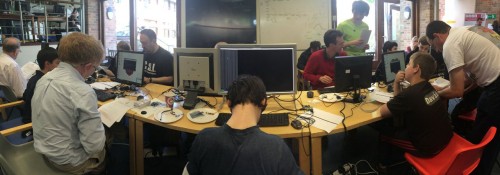 Young and old alike getting to know distance sensors and line followers in a workshop led by Zach Igielman (standing, in the green t-shirt) In the lecture theatre, Alan O'Donohoe was up next: Engage and Inspire the Digital Creators of Tomorrow: … followed by Craig Richardson giving a talk on using Minecraft in the classroom: Out in the Foyer, Ryan Walmsley started off his workshop on controlling motors with the Pi, whilst in the meeting room Phil Howard and Jim Darby began their session on creating an Arduino and programming it with the Pi (we're supporters of the school of thought that these devices can work together rather than in competition with one another!). 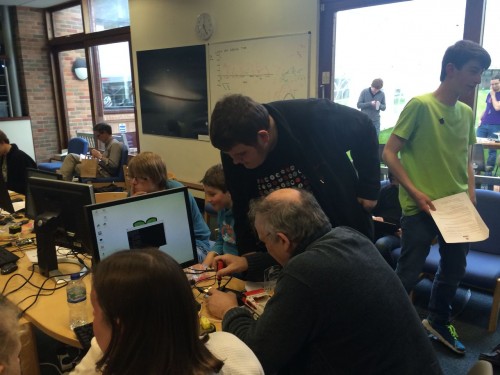 Ryan and Zach at the motor controller workshop, soldering workshop in the background outside Back in the lecture theatre, Nevil Hunt talked about his invention, the Seven Segments of Pi, and how it can be used in schools: Then, we had a talk from James Robinson from Computing at School: And finally… we had a panel session that involved some of the Picademy graduates and was chaired by David Whale: Then the big get-out began. This was a mammoth task at the end of a very long day. Many, many thanks to those who helped with both the get-in and, especially, the get-out. Without you guys we'd probably still be there! All that was left to do was to drive home and… oh yeah… empty out both cars. Argh!!! AftermathAnd so, the May Cambridge Raspberry Jam was over. It would be fair to say that neither Mike nor Tim could form a coherent sentence the next day, but it was worth it! We sent feedback forms out to attendees and, judging by the response, people were, on the whole, very happy with the way the day went. We certainly felt as though it had been a success, both in Focus on Education and in the activities in the Foyer/Meeting room. What's next? Well, we have a fair amount of work still to do for this Jam. We need to analyse all the feedback and come up with a list of 'lessons learnt'. We also need to resort all the equipment we hurriedly packed and brought back from the Jam into the correct boxes. And then there's the small matter of the Jam on 5th July… and possibly a Potton Pi & Pints in June! Right then… to the pub! If you want to find out more about the Cambridge Raspberry Jam, visit our website at http://camjam.me or come and watch some more videos on the YouTube channel. |
A Semi-automated Technology Roundup Provided by Linebaugh Public Library IT Staff | techblog.linebaugh.org
Thursday, May 15, 2014
Cambridge Jam: focus on education
Subscribe to:
Post Comments (Atom)
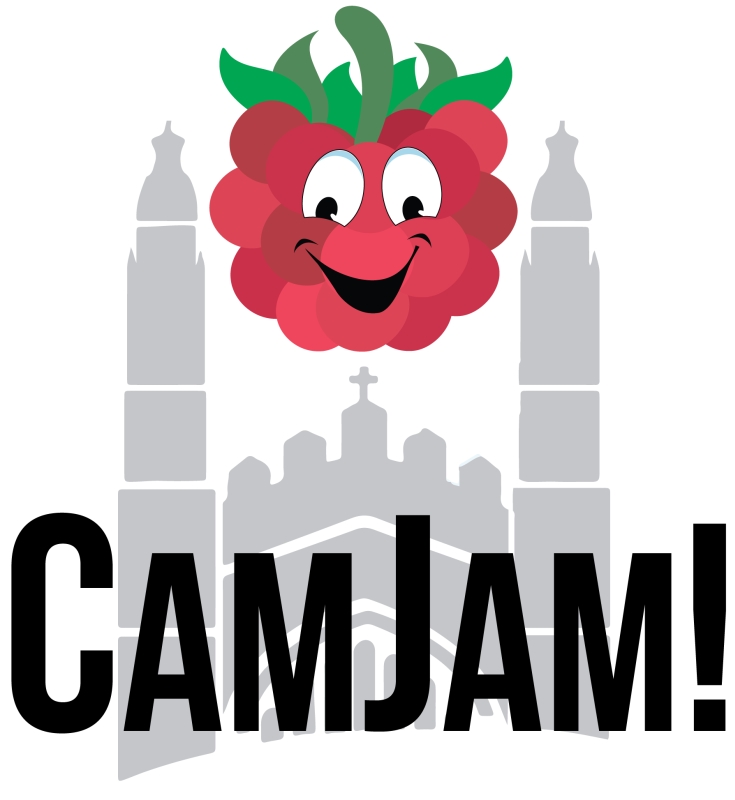 We (
We (
No comments:
Post a Comment